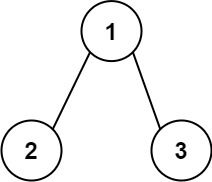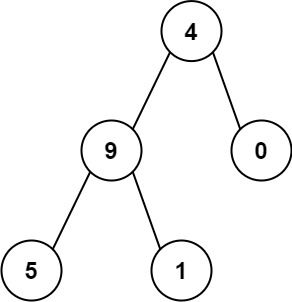给定一个二叉树的根节点 root ,树中每个节点都存放有一个 0 到 9 之间的数字。
每条从根节点到叶节点的路径都代表一个数字:
- 例如,从根节点到叶节点的路径
1 -> 2 -> 3表示数字123。
计算从根节点到叶节点生成的 所有数字之和 。
叶节点 是指没有子节点的节点。
示例 1:

输入:root = [1,2,3] 输出:25 解释: 从根到叶子节点路径1->2代表数字12从根到叶子节点路径1->3代表数字13因此,数字总和 = 12 + 13 =25
示例 2:

输入:root = [4,9,0,5,1] 输出:1026 解释: 从根到叶子节点路径4->9->5代表数字 495 从根到叶子节点路径4->9->1代表数字 491 从根到叶子节点路径4->0代表数字 40 因此,数字总和 = 495 + 491 + 40 =1026
提示:
- 树中节点的数目在范围
[1, 1000]内 0 <= Node.val <= 9- 树的深度不超过
10
注意:本题与主站 129 题相同: https://leetcode-cn.com/problems/sum-root-to-leaf-numbers/
DFS。
# Definition for a binary tree node.
# class TreeNode:
# def __init__(self, val=0, left=None, right=None):
# self.val = val
# self.left = left
# self.right = right
class Solution:
def sumNumbers(self, root: TreeNode) -> int:
def dfs(root, presum):
if root is None:
return 0
s = 10 * presum + root.val
if root.left is None and root.right is None:
return s
return dfs(root.left, s) + dfs(root.right, s)
return dfs(root, 0)/**
* Definition for a binary tree node.
* public class TreeNode {
* int val;
* TreeNode left;
* TreeNode right;
* TreeNode() {}
* TreeNode(int val) { this.val = val; }
* TreeNode(int val, TreeNode left, TreeNode right) {
* this.val = val;
* this.left = left;
* this.right = right;
* }
* }
*/
class Solution {
public int sumNumbers(TreeNode root) {
return dfs(root, 0);
}
private int dfs(TreeNode root, int presum) {
if (root == null) {
return 0;
}
int s = presum * 10 + root.val;
if (root.left == null && root.right == null) {
return s;
}
return dfs(root.left, s) + dfs(root.right, s);
}
}/**
* Definition for a binary tree node.
* struct TreeNode {
* int val;
* TreeNode *left;
* TreeNode *right;
* TreeNode() : val(0), left(nullptr), right(nullptr) {}
* TreeNode(int x) : val(x), left(nullptr), right(nullptr) {}
* TreeNode(int x, TreeNode *left, TreeNode *right) : val(x), left(left), right(right) {}
* };
*/
class Solution {
public:
int sumNumbers(TreeNode *root) {
return dfs(root, 0);
}
int dfs(TreeNode *root, int presum) {
if (root == nullptr)
return 0;
int s = presum * 10 + root->val;
if (root->left == nullptr && root->right == nullptr)
return s;
return dfs(root->left, s) + dfs(root->right, s);
}
};/**
* Definition for a binary tree node.
* type TreeNode struct {
* Val int
* Left *TreeNode
* Right *TreeNode
* }
*/
func sumNumbers(root *TreeNode) int {
return dfs(root, 0)
}
func dfs(root *TreeNode, presum int) int {
if root == nil {
return 0
}
s := presum*10 + root.Val
if root.Left == nil && root.Right == nil {
return s
}
return dfs(root.Left, s) + dfs(root.Right, s)
}